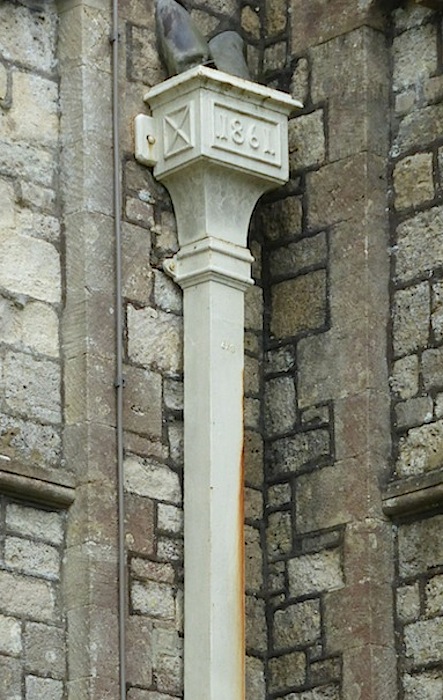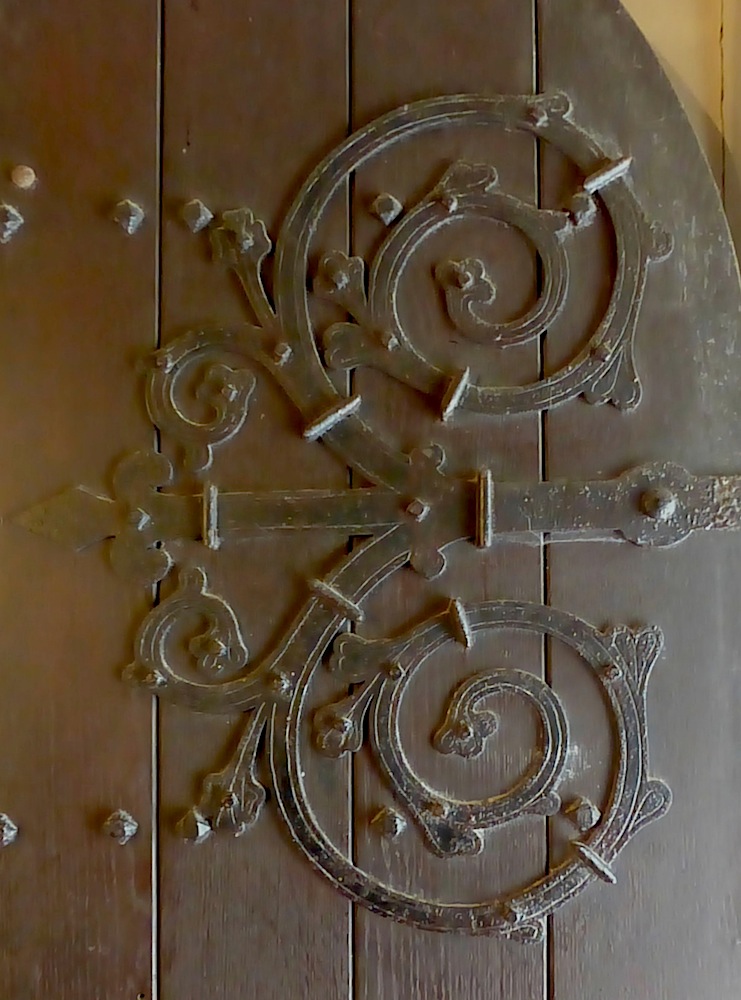Photographs and text by Jacqueline Banerjee. You may use these images without prior permission for any scholarly or educational purpose as long as you (1) credit the photographer and (2) link your document to this URL or cite it in a print document. [Click on the images for larger pictures.]


Left: The church of St Mildred, on the Isle of Wight: the lych-gate and east end, seen from the road. Right: The east end seen from inside the churchyard.
St Mildred, Whippingham. Medieval in origin, this was the estate church for Osborne, which became a royal residence in the early 1850s. It had been altered in 1804-05 by John Nash, but was completely rebuilt by A. J. Hubert (1821-1877) under the direction of Prince Albert. Now Grade I listed, the church is on Beatrice Avenue in East Cowes, on the Isle of Wight.


Left: The Anglo-Saxon carving preserved on the west wall of the porch. Right: The south porch itself.
So thorough-going was the Victorian rebuilding that the only visible reminder of the original church is the early, weather-worn carving shown above left. Work began after Thomas Cubitt, engaged on the rebuilding of the main estate, introduced A. J. Hubert (1821-1877) to the Prince Albert. The brief guide available in St Mildred's states simply that "the building you see today was designed by Prince Albert," but Michael Turner indicates that there was a more collaborative approach: "The prince suggested the basic external form of the new church, but Humbert produced over 200 sketches and working drawings." The rebuilding was carried out in two phases, in 1854-55 and then in 1861-62.

The west end with its wooden bell tower and flèche.
Humbert's first task, under Prince Albert's guidance, was to rebuild the chancel and add south and north chapels, the former with its own entrance for the royal family, and the latter originally for the royal household. This was accomplished in 1854-55. Next, in 1860-62, the rest of the church was rebuilt: the nave, transepts — and that huge central tower, with turrets at its angles. Opinions about the result are mixed. "It is a weird design, especially the tower, in a mixture of Romanesque and early Gothic" say David Lloyd and Nikolaus Pevsner (293); in the listing text, following a sceptical comment that "Prince Albert is supposed to have had a hand in the design," the church is described a little more elaborately as having been built "in a kind of Rhenish Gothic style with Norman and Italian Romanesque influences."



Left to right: (a) The foundation stone of the rebuilt nave. (b) View of the north transept and tower, and north chapel. (c) The drainwater head here is dated 1861.
The foundation stone of the rebuilt nave was laid by the Queen and Prince Albert on 29 May 1860, and there is much else to suggest their connection with the church. As well as commenting on the hefty tower at the crossing, Simon Jenkins looks askance at the attempts to give the building some Gothic verticality (see 304). This is where the "Rhenish" influence comes in: the tall capped structures perched like chimney-stacks on each of the chapel roofs associate the building with the picturesque castles along the Rhine, and help to make St Mildred's quite endearingly unique.



From left to right: (a) The elaborate Romanesque porch for the royal churchgoers. (b) Victoria and Albert's entwined initials over it. (c) The elaborate ironwork on the door.
Another special touch is the private entrance for the Queen and her family, with its eclectic mixture of Corinthian columns, a round-headed Norman arch with dogtooth carving, recessed pilasters, and a wooden door with Gothic ironwork. Its purpose is clearly indicated by the pedimental trefoil containing their initials in a leafy design. Above the pediment is a rectangular heraldic panel with the crowned British lion peeping out on the left — click here to see.

Close-up of the war memorial.
The war memorial too has royal connections, albeit of a later date. Described as an "[o]penwork iron cross with trefoiled ends, on [a] stone base" (Lloyd and Pevsner 295), it was unveiled by Princess Beatrice, Victoria and Albert's ninth child, who was married to Prince Henry of Battenberg in the church on 23 July 1885, and who was then Governor of the Isle of Wight. She had lost her son, Prince Maurice of Battenberg, at Ypres in 1914 (see "The Royal Church"), and his name is at the top of the list inscribed on the stone panels on the wall behind.
Related Material
Bibliography
"Church of St Mildred." Historic England. Web. 1 October 2017.
"The Royal Church of St Mildred, Whippingham, Isle of Wight." Brief guide available in the church.
Jenkins, Simon. England's Thousand Best Churches. Rev. ed. London: Allen Lane, 2004.
Lloyd, David W., and Nikolaus Pevsner. The Buildings of England: Isle of Wight. New Haven and London: Yale University Press, 2006.
Turner, Michael. "Humbert, Albert Jenkins (1821-1877." The Oxford Dictionary of National Biography. Online ed. Web. 1 October 2017.
Created 1 October 2017